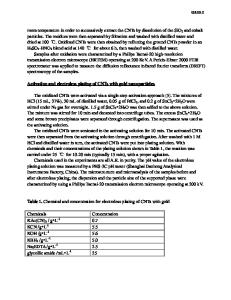Structures and Optical Properties of Nanoforest-Like Carbon Nanotubes Decorated with Nanoparticles of Strontium Aluminat
- PDF / 637,168 Bytes
- 6 Pages / 432 x 648 pts Page_size
- 89 Downloads / 368 Views
MRS Advances © 2018 Materials Research Society DOI: 10.1557/adv.2018.245
Structures and Optical Properties of Nanoforest-Like Carbon Nanotubes Decorated with Nanoparticles of Strontium Aluminate Doped with Rare-Earth Elements Patsy Y. Arquieta Guillén1, Alena Borisovna Kharissova1, Beatriz Ortega García1 and Oxana V. Kharissova1 1
Universidad Autónoma de Nuevo León, Av. Universidad S/N, Ciudad Universitaria, San Nicolás de los Garza, N.L., C.P. 66455, México.
ABSTRACT
Nowadays, carbon nanotubes have a lot of applications in daily life, being applied in the fabrication of cellphones, computers, nanotransistors, among many others. Currently, their new applications in biotechnology area are in research, in particular in order to find new biosensors with fluorescent properties applying on the basis of multi-wall carbon nanotubes (MWCNTs). In this work, the obtaining of carbon nanoparticles having fluorescent properties via spray pyrolysis is presented. Synthesis, properties, structural peculiarities, and applications of nanobuds and related nanostructures are discussed. MWCNTs, decorated with strontium aluminate SrAl12O19 and doped with rare-earth elements, were synthetized from distinct organic precursors and the corresponding metal oxides. The metal oxides used were Samarium (Sm), Europium (Eu), Neodymium (Nd), Lanthanum (La), Cerium (Ce) and some their combinations.
The synthesis was carried out on the surface of optical fibres to obtain a uniform growth of forest-like MWCNTs, adding to metal oxide nanoparticles to their surface. The preparation of composites was carried out by spray pyrolysis techniques in dry nitrogen atmosphere in the temperature range from 780 to 850oC. The formed products were characterized by Scanning Electron Microscopy (SEM), Transmission Electron Microscopy (TEM), FTIR spectroscopy, Raman spectroscopy and UV/visible spectroscopies. The analysis of the obtained data shows that the deposited nanoparticles are in the range of size 20-60 nm being uniformly distributed on the surface of MWCNTs. The samples, obtained at different temperatures and with doping metal oxides added to SrAl12O19, show different fluorescence behavior. The best results were observed with lanthanum oxide as a dopant. Possible applications as persistently luminescent phosphors for the formed MWCNTs-supported luminescent materials are proposed.
121
Downloaded from https://www.cambridge.org/core. Access paid by the UCSB Libraries, on 16 Mar 2018 at 20:10:00, subject to the Cambridge Core terms of use, available at https://www.cambridge.org/core/terms. https://doi.org/10.1557/adv.2018.245
INTRODUCTION The carbon nanotubes research has been increased in the recent years included their application into different fields of our daily life. The scientists are searching for the study of its optical properties and novel ways to improve these properties. Since 2013 some researches was focused on the development of a biosensors to made an In vivo biosensing using carbon nanotubes doped with a fluorophore to obtain fluorescent
Data Loading...










